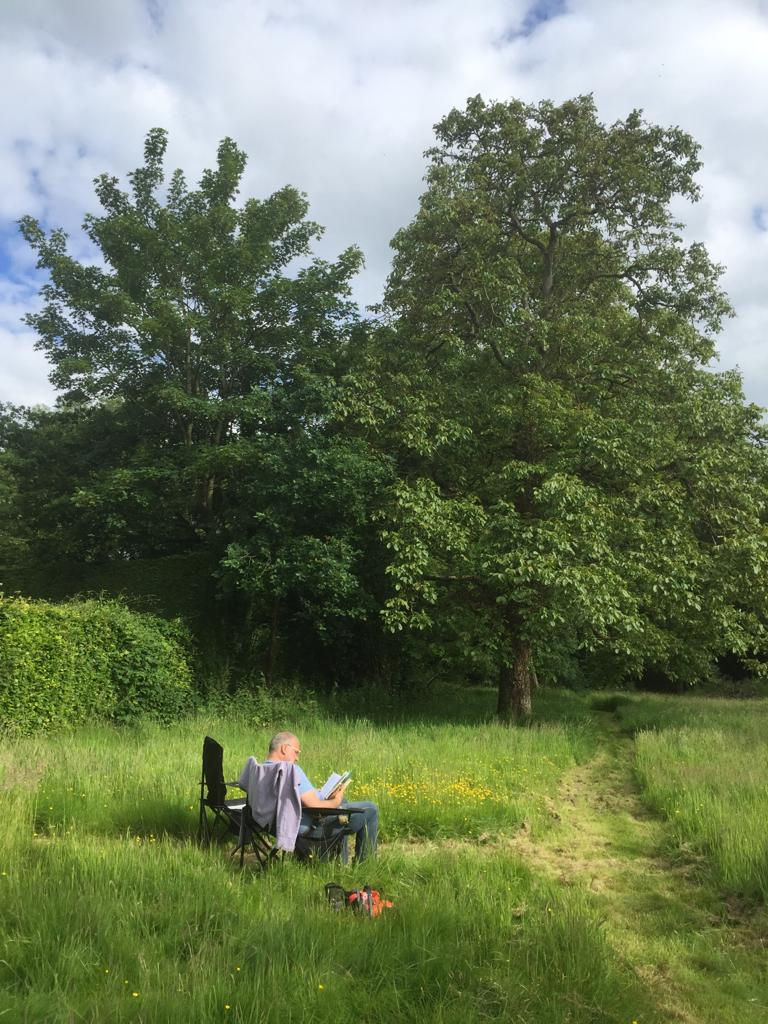Tree Bumblebee - Bombus Hypnorum - with my Tea
- Neil

- Jun 22, 2019
- 3 min read

I am a birder essentially but now I am getting proprietorial about a few acres in Herefordshire I did promise a bit of a bio-Blitz on the place. The more we look the more we see and recently Jane and I have started to really notice the bees. I am nothing if not an anorak when it comes to these things so of course I bought myself a field guide. Off the top of my head I guess I had heard of Honey Bees, Bumblebees, Mining Bees and possibly even Carder Bees. I had no idea that Bees were so diverse. We now have 270 species of Bee in the UK and that number has been increasing in recent years with the onset of climate change.
I had a lovely full day at the bottom of the meadow and just inside the wood yesterday - what I have termed Indonesia while I am in invasive Laurel slash and burn mode. It is far too easy to just get your head down and work all day. We had promised a full stop for the working day and a cup of tea or a drink at 5 pm. Here I am run aground in Arcadia, with my trusty chainsaw set aside for the day !

Jane has bought two camp chairs for the ritual which we set up half way down the meadow.

When you are quiet and sat still you begin to notice just how many insects are toiling around in the knee length grass. Time to deploy the Steven Falk's Field Guide to the Bees of Great Britain and Ireland from the wonderful Bloomsbury Wildlife Guide series.

Thankfully the first bee I have really tried to identified turned out to be quite a easy one. My "childlike" genus appreciation of bees as either Honey or Bumble is so far from the biological truth its shaming. So we need our "long-awaited and authoritative field guide that will surely generate much-needed interest in the "forgotten bees", the small and often solitary species that are too often overlooked" (Professor Dave Goulson).
There are in fact 6 Genera of bees that we need to contend with. Colletidae (Plasterer bees, Yellow-faced Bees), Andrenidae (Mining Bees and Shaggy Bees), Halictidae (End-banded Furrow Bees, Base-banded Furrow Bees, Blood Bees, Bristle-headed Bees, Short-faced Bees), Melittidae (Blunt-thorn Bees, Oil-collecting Bees, Pantaloon Bees), Megachilidae (Wool Carders, Dark Bees, Resin Bees, Scissor Bees, Mason Bees, Lesser Masons, Leafcutter and Mud Bees and Sharp-Tailed Bees) and Apidae (Nomad Bees, Variegated Cuckoo Bees, Long-Horned Bees, Flower Bees, Mourning Bees, Small Carpenter Bees, Large Carpenter Bees, Bumblebees and Honey Bees). So the world is not straight foward as this 50 year thought when it comes to the humble bee.

Our new Bee is clearly a fine gingery fellow in his upper body (Thorax), a black bottom section (Abdomen) and white tail. Heading off into the Field Guide with that very simple split I was able to hove in on the Bumblebees which seem to have some lovely gingery candidates,

Mercifully only one bee seems to have the edge top to bottom Ginger, Black then White combination. The beautiful - well because I now know what they are called, Tree Bumble Bee. Bombus Hypnorum.

There is something deeply fascinating about knowing the name of something in the natural world with a degree of precision. Knowing somethings name properly opens up a world of useful information. The world becomes a more interesting place.
These bees were first discovered in the UK in 2001 and have been steadily spreading North. I am not sure if this is the result of climate change but I expect so. I am used to the pattern with birds. We are now seeing birds like Purple Heron, Great-White Egret turning up and of course the Little Egret has taken the UK by storm in the last 30/40 years. So it may be the same with bees I guess. Little Renet here has Channel hopped just in this century taking advantage of a degree or two of extra heat, These are social Bees forming colonies of up to 300 Bees usually in in a raised situation like a hole in a tree, house eves or even an abandoned nest box.
So my first proper Bee identification takes us straight in climate change or climate "crisis" as the BBC has now truth-speaker the issue. Maybe Renet doesn't belong here in Herefordshire but he is most welcome for now.

He doesn't take up so much room. Bienvenue Bombus Hypnorum.



Kommentare